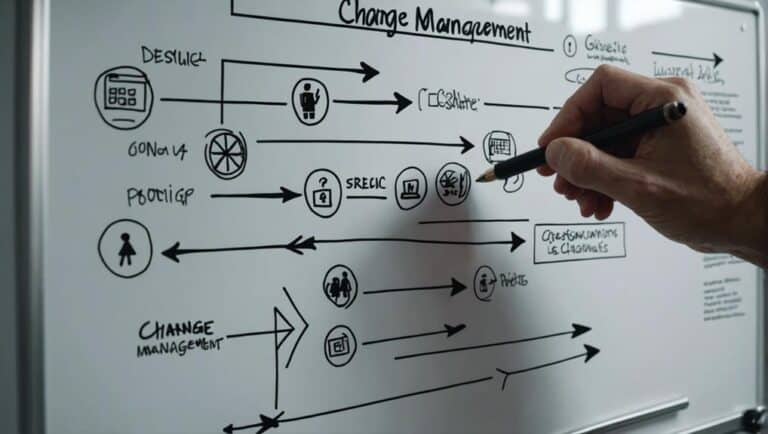Imagine a sailboat navigating through turbulent waters, adjusting its course to reach its destination efficiently. Change management serves as the rudder guiding organizations toward improved performance outcomes.
By understanding the intricate balance of change and performance, you can unlock the potential for growth and success within your organization.
But how can you ensure a smooth voyage through these waters?
Key Takeaways
- Clear communication and stakeholder engagement are crucial for driving performance improvement.
- Leadership support and effective change implementation processes are vital for successful outcomes.
- Overcoming resistance through open communication and strategic approaches enhances change effectiveness.
- Monitoring progress, sustaining improvements, and fostering a culture of continuous enhancement are key for long-term success.
Understanding Performance Improvement Through Change
To fully grasp the essence of performance improvement through change, one must delve into the intricate dynamics that drive organizational evolution and success. Management plays a pivotal role in orchestrating effective performance improvement initiatives by fostering a culture that embraces change. Understanding the symbiotic relationship between change management and performance improvement is fundamental to navigating the complexities of organizational transformation. Developing a robust communication plan is crucial in ensuring that all stakeholders are aligned with the objectives of the change, fostering transparency, and minimizing resistance.
Organizational culture, deeply ingrained in the fabric of an organization, can either be a catalyst or a hindrance to performance improvement efforts. Effective change management strategies are instrumental in reshaping organizational culture to align with the desired outcomes of performance enhancement. By proactively addressing cultural barriers and leveraging communication channels, management can create a conducive environment for change to flourish and drive sustainable performance improvements.
Key Principles of Change Management
In navigating change management for performance improvement, understanding the key principles becomes paramount for orchestrating successful organizational transformation. Change management involves guiding individuals through technical and emotional aspects of change to achieve desired outcomes. To ensure successful change, gain buy-in, and implement performance management processes effectively, consider the following key principles:
- Clear Communication: Transparent and consistent communication is essential to keep all stakeholders informed about the change initiative, its purpose, and potential impacts. This fosters trust and reduces uncertainty.
- Stakeholder Engagement: Involving key stakeholders throughout the change process increases their ownership and commitment to the transformation. Their input can provide valuable insights and perspectives for a smoother transition.
- Leadership Support: Strong leadership support is crucial in driving successful change. Leaders must actively demonstrate their commitment to the change, align actions with the organizational goals, and inspire others to follow suit.
Strategies for Successful Change Implementation
Engage stakeholders proactively through decision-making processes and change implementation to ensure their commitment and alignment with organizational transformation goals.
Effective change management involves clear and consistent communication to foster understanding and alignment with change objectives. By involving stakeholders in performance conversations, you can gather valuable insights and feedback, increasing buy-in and support for the change initiative.
Providing training, resources, and support is crucial to empower employees during transitions, enabling a smoother transition and reducing resistance. Implementing management strategies to monitor progress and address challenges promptly is essential for successful change implementation.
Celebrating successes and recognizing efforts not only maintains momentum but also reinforces the desired change behaviors. By offering support and involving stakeholders throughout the process, you can enhance the likelihood of a successful change implementation and drive performance improvement within your organization.
Overcoming Resistance to Change
By addressing employees' concerns and emotions directly, organizations can effectively navigate and mitigate resistance to change initiatives. Resistance to changing performance management can be overcome by implementing strategic approaches:
- Transparent Communication: Ensure open and honest communication about the reasons behind the change, its benefits, and how it aligns with the organization's goals. Clear communication helps employees understand the need for change and reduces uncertainty.
- Support and Training: Provide employees with the necessary support, resources, and training to help them adapt to new processes or systems. Empowering employees with the right tools and knowledge can increase their confidence in navigating the changes.
- Employee Involvement: Involve employees in the change process by seeking their input, feedback, and active participation. When employees feel like they've a voice in the change process, they're more likely to support and embrace the new initiatives.
Monitoring Progress and Sustaining Improvements
Navigating through the process of overcoming resistance to change in performance management, the focus now shifts towards monitoring progress and sustaining improvements for long-term success. To ensure continual advancement, it's crucial to establish a clear understanding of the current state by implementing regular performance reviews, evaluations, and feedback sessions with employees. By utilizing key performance indicators (KPIs) and data analytics, you can track success metrics, identify areas for improvement, and uncover trends that may require further enhancement.
To sustain improvements effectively, it's essential to design and implement a feedback mechanism that encourages ongoing learning and adaptation. This continuous improvement culture fosters a proactive approach to change management, where employees are actively engaged in the process of enhancing performance. The desired state involves creating a dynamic environment where performance improvements aren't seen as one-time events but as ongoing aspects of change. By incorporating these key messages into your strategy, you can drive sustainable improvements and achieve long-term success in performance management.
Frequently Asked Questions
What Is Performance Management in Change Management?
In understanding performance management in change management, it involves performance evaluation, team alignment, leadership communication, employee engagement, and continuous improvement. It aligns individual and team goals with organizational objectives to drive improvement and success.
What Are the 5 C's of Change Management?
You need to grasp the 5 C's of Change Management: Communication, Commitment, Culture, Control, and Coordination. Stakeholder engagement, resistance management, leadership alignment, cultural shift, and impact assessment are crucial facets for successful change.
What Are the 5 R's of Change Management?
When navigating change, remember the 5 R's: Reason, Return, Risk, Resources, and Resilience. These elements guide effective change management by addressing purpose, benefits, obstacles, support, and adaptability. Stay focused on these pillars for successful transformations.
What Are the 7 C's of Change Management?
When navigating change management, remember the 7 C's: clarity, commitment, communication, consultation, cooperation, coordination, and consistency. Ensure stakeholders are engaged, use a robust communication strategy, address resistance, and prioritize training and development for effective performance improvement.
Conclusion
You have learned the key principles of change management and strategies for successful implementation to drive performance improvement. Remember, 'change is the only constant.'
Embrace change, overcome resistance, monitor progress, and sustain improvements to achieve organizational success. By aligning individual goals with organizational objectives and ensuring IT efficiency, you can enhance efficiency, productivity, and competitiveness in the market.
Stay agile, adapt to change, and strive for continuous improvement to drive sustainable transformation.





